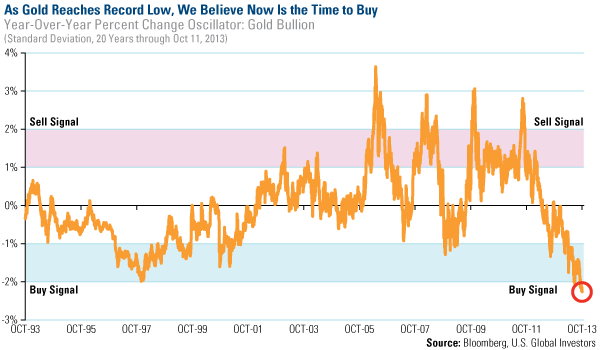Gold Market Radar (October 21, 2013)
For the week, spot gold closed at $1,316.18, up $44.07 per ounce, or 3.46 percent. Gold stocks, as measured by the NYSE Arca Gold Miners Index, rose 5.56 percent. The U.S. Trade-Weighted Dollar Index lost 0.93 percent for the week.
Strengths
- Gold rose nearly 3 percent on Thursday following the resolution reached in Congress avoiding U.S. government default. However, as James Steel of HSBC argues, the resolution left investors sufficiently uncertain as to whether the suspension of the debt ceiling only delays another showdown in Congress come February. Yet, another important factor that acted to move gold on Thursday was a trade in the early hours of the New York morning, when gold trading is very thin, and a wave of buy orders worth over $2.3 billion surged into the market. Prices soared, puzzling many traders who have been rattled by a series of similarly abrupt, and largely unexplained, trade surges over the past two weeks. The key difference this time around is the fact that the overnight spike occurred at around the same time as Chinese rating agency Dagong’s downgraded the United States credit rating to A- from A. Reuters reports the agency suggested that, while a default has been averted by a last-minute agreement in Congress, the fundamental situation of debt growth outpacing fiscal income and GDP remains unchanged. Dagong's ratings are hardly followed outside of China, yet they must have a respectable following capable of a $2.3 billion buy order.
- Mineweb reported that India had imported over 4,000 tons of silver year to date, which extrapolated over the full year, would mean India importing over 6,000 tons in 2013, or over three times last year’s imports. Not only has silver demand risen, gold premiums surged in China and India indicating continued strong physical buying from Asian consumers. Gold premiums in India hit a record $100 per ounce as the decline occurred amid India’s key gold buying season ahead of the gold-buying holiday, Diwali. The triple-digit price premium is a reflection of the inability of local merchants in India to secure supplies of imported gold.
- VTB Capital reports Russia’s first gold-backed ETF “The FinEx Physically Held Gold ETF fund” has been launched by FinEx Group and the Moscow Exchange. The new ETF is listed on the Moscow Exchange and cross-listed on the Irish Stock Exchange. The new ETF is following a similar product launched in Shanghai, while seeking to benefit from Russia’s increasing gold jewelry demand which rose 7.6 percent in 2012.
Weaknesses
- St. Joseph Partners weekly gold review brought to our attention an interview with Paul Singer, founder of $20-billion Elliott Management Corporation, which has had only two down years since its inception in 1977, and whose returns have roughly exceeded the markets by 40 percent over that period. In the interview, Singer remarks that his company has direct beneficial owners of about 130 million people, who in turn control several trillion dollars. His clients range from sovereign wealth funds to pension funds and endowments, meaning he has a wide investor base. However, the most concerning comment of his interview is the fact that out of his client base, Singer has yet to find one who has any position hedging them against inflation. Singer as a seasoned market veteran is aware that the first wisps of inflation are hard to detect, but those wisps may cause a self-reinforcing move in markets and have the potential to cause an “electrifying” move in gold because of the narrow, non-expandable supply of gold. Singer states that those who are under-invested in gold, and who think they can predict when the tide will turn, are making a large mistake.
- Scotia Capital predicts most mining company gold reserves and resources will be generally lower for the upcoming year-end reserves estimates as gold price assumptions will be lower than 2012 reserve estimates. In general, Scotia Capital also expects reserves will decline as higher cost ounces are removed, with the silver lining that these will result in an overall improvement in grade and profitability.
- Colossus Minerals is losing investors’ patience as its balance sheets wear thin, according to Haywood. Colossus Mineral's Serra Pelada project in Brazil has encountered significant technical challenges brought on by water and challenging ground conditions. Haywood believes the options for raising new capital are few and expect that any future cash injections would likely be arranged under highly punitive terms. With the prospect of adding further financial burden to what is already a leveraged capital structure in the context of a soft metal price environment is of great concern to the analysts at Haywood. Given management's failure to budget and operational challenges that remain, Haywood downgraded Colossus to a sell recommendation.
Opportunities
- Over the past 20 years, gold bullion is down 2 standard deviations (sigma) year-over-year as of October 11, 2013. A reading of 2 sigma or lower is an extremely rare occurrence, happening only 21 times over the last 20 years, or 0.04 percent of the time. The most curious fact is that these 21 occurrences all happened within the last four months. This analysis leads us to believe that gold is in extremely oversold territory and mathematically due for a reversal toward the mean. Often, when gold prices plummet, fear takes over and investors forget our recommendation to own 5 to 10 percent gold in a portfolio. Gold is a diversifier for almost every portfolio, and should be held as a store of value. We argue gold should not be considered as a way to get rich quick because the inherent volatility is too high.
- The gold market has been hijacked by big sellers of paper gold according to Jeff Nichols, adding these transactions are being made with “nary an ounce of physical gold actually changing hands.” He warns “gold remains vulnerable and possibly quite volatile…but it is becoming increasingly attractive to long-term investors with a significant rise in the price all the more likely over the next three-to-five years.” The rationale is that the U.S. Fed continues to duck tapering, indirectly pumping more and more dollars into the economy. In addition, the U.S. economy is perhaps less robust than many observers believe. Yet the most important reason is the continuing demand in the East. Consider this: The U.K. exported 98.2 tons of gold to Switzerland in August 2013, roughly coincidental with the amount of bullion redeemed from gold-backed ETF products, which is transformed into bars and other products more conducive to Asian consumers. Gold imports from these two countries are set to reach record highs this year, even in the face of massive portions of gold being smuggled into the countries.
- John Hathaway, a renowned gold portfolio manager, commented last week how in his opinion a couple of bullion banks are using their balance sheets to sell gold they don’t possess. These entities are moving a major market by making leveraged bets, but they do it without having to take physical possession and short the way it would be done on a normal exchange. Perhaps these players believe that gold is such a small part of the global investment scene that it can be manipulated for their own benefit with total impunity. What they ignore is the fact that there are gold believers with virtually unlimited pockets – the Chinese in particular – who must be feeling every day is Christmas as they rake in physical gold at depressed prices, knowing that at some day in the future, the yellow metal’s price will soar. It will result in a massive short squeeze for these market manipulators.
Threats
- Tom Kendall, head of Precious Metals research at Credit Suisse, speaking on Mineweb's Gold Weekly podcast, said the problem gold has at the moment, "is that even if you are an investor who believes that you should have a significant allocation to gold as a hedge against inflation or some other... risk hedge, you probably accumulated that allocation through 2009, 2010, 2011 and you don’t need to add to it at the present time, or until there is a feeling that there is a greater prospect of inflation on the horizon." Looking to China, he says, "the market certainly is not nearly as strong as it was during the first half of the year and the Chinese are as reluctant as any other buyer to buy heavily in a market which tends to be trending downwards.” In our opinion Mr. Kendall has not been reading the news lately, especially given HSBC and others are reporting gold demand across Asia will keep expanding as inflation spurs investment purchases. HSBC adds that in markets like India, Vietnam and China, consumers have few tools with which to protect their savings against rising prices, and “In recent years, rising inflation stoked demand for gold in a number of [these] markets.” To go even further, Kendall must have missed Gluskin Sheff David Rosenberg’s latest reports in which he has gone to great lengths to show the prospect of inflation is quite real, and already among us. To paraphrase just one of his most recent commentaries: Rosenberg shows it cost $9 to go to the top of the Empire State Building in 2001, today it costs $44. The MoMA entrance cost $10 in 2001, and now it costs $25. A taxi ride from JFK Airport to Manhattan cost $30 then, but now it starts at $52. If you were to plug those rates into the CPI calculation, we’d have 4.1 percent headline inflation, and 5.2 percent core inflation.
- Dundee Capital Markets reports that as we head into the final months of 2013, the season for tax loss selling is quickly approaching, which means a large number of funds and retail investors will be wrapping up their tax years in the calendar fourth quarter. Given the generally poor performance observed in precious metal equities over the past year, gold stocks have become likely candidates for tax loss selling this year.
- Last Friday’s large drop in gold was a result of one tremendously large sell order, which offered 500,000 gold ounces or about $650 million dollars for sale at market price. According to Seeking Alpha contributor Hebba Investments, no seller trying to get a fair price for their gold would sell in such a way, leading to the conclusion that the trade was made to ignite negative momentum. It is important to put the sell order into context given the size of this trade compared to the size of COMEX gold registered inventories. The order represents almost 70 percent of gold available for delivery at COMEX and would be most certainly impossible to deliver. To make it even more dramatic, this took less than one minute, meaning essentially all of the COMEX gold eligible for delivery was sold by one trader in less than one minute. If that doesn't catch a regulator’s attention for market manipulation, then nothing will.
















